Platforms offering e-learning reveal new opportunities for users. Students can gain new skills with self-paced online courses, and instructors can share their expertise with a broad audience who uses digital devices.
Online courses have become a great alternative to traditional education, allowing you to obtain new skills and grow personally and professionally. The leading e-learning websites are Coursera and Udemy, which attract millions of users who want to gain new knowledge.
So, what makes them outstanding examples of educational platforms? How to build a website like Udemy or Coursera that can compete with these giants?
As experts in building custom marketplaces, we share our expertise about online learning websites in this article. Let’s see the details of how to create an elearning website and how such platforms deliver the best user experience.
E-learning portal definition and benefits
In brief, e-learning, or electronic learning, is training delivered via digital devices. These gadgets (computers, tablets, and smartphones) should be connected to the Internet. Students do not have to be present in the class and can learn at their own pace.
Today, digital education platforms have become an impactful and convenient tool.
E-learning websites like Udemy or Coursera are becoming increasingly popular owing to their undeniable benefits. According to G2, a leading software review platform, 77% of companies improved their workflow after adopting e-learning. Let’s discuss the core advantages of a website like Udemy in more detail:
- Flexibility. With online education websites, students can take courses anytime, anywhere. They no longer need to travel to educational institutions. Instead, learners study in the comfort of their homes. It is a real catch for people who have a full-time job or cannot attend a college or university.
- Self-paced mode. Students are free to set the schedule according to their individual needs.
- Lower costs. Online programs on websites like Udemy or Coursera are often cheaper than tuition in a traditional campus environment. Besides, learners save money on course materials, accommodation, and commuting.
Types of digital learning platforms to keep in mind when you create elearning website:
- MOOCs (Massive Open Online Courses), e.g., Udemy, Coursera, Udacity, or FutureLearn
- Virtual learning environment (VLE), e.g., Wooclap
- Video streaming services, e.g., YouTube
- Learning management systems (LMS), e.g., SC Training, Moodle or Blackboard Learning
- Discussion boards, e.g., Kialo
- Forums for teachers, e.g., Apple Education Community
- Podcasts, e.g., Hardcore History, Philosophize This!
We have already mentioned Udemy and Coursera as two leading e-learning marketplaces. Other high-profile platforms are FutureLearn, edX, Khan Academy, Skillshare, and Udacity. You can check them as inspiring examples when you create your own e learning website.
You may also like: How to Create an Online Service Marketplace
Udemy and Coursera: detailed comparison
Before we dive deep into a detailed comparison of Udemy and Coursera, let’s see how they appeared. The story of each of them shows the roots and key values the platforms offer today.
Udemy - the world’s biggest online learning platform
The history of Udemy dates back to 2007. Then, Eren Bali came up with the idea of creating software for a live virtual classroom. Bali noticed that gifted people sometimes do not have the ability to advance their skills. Thus, he decided to create e learning website to help adults with their education.
The first attempt at building an online education marketplace failed. So Bali and his friend Oktay Caglar packed their bags and moved from Turkey to Silicon Valley. There, they gave their project another try. At first, more than 30 investors rejected the idea. Finally, in 2010, Bali launched the platform.
Currently, approximately 85,000 instructors offer courses in 75 languages on Udemy. The website library contains around 250,000 courses. Additionally, Udemy offers courses to over 17,000 business customers, with 40% of Fortune 500 companies among its business customers.
What contributes to Udemy’s success is that it takes care of both sides that use its platform, students and instructors. Udemy keeps track of current trends and marketing opportunities. So, the platform gives insightful information to instructors who create helpful courses with up-to-date data for students.
Coursera - a platform transforming learning for students around the world
The founders of Coursera are Daphne Koller and Andrew Ng, computer science professors from Stanford University. They started offering their courses online and, in 2012, left the university to run Coursera.
The platform’s goal is to make high-standard education available to people around the world. Today, 275+ universities and companies provide over 4000 courses through Coursera.
Among contributors are the University of Michigan, the University of Pennsylvania, the Illinois Institute of Technology, Stanford University, Yale University, IBM, Google, Meta, DeepLearning.AI, and more.
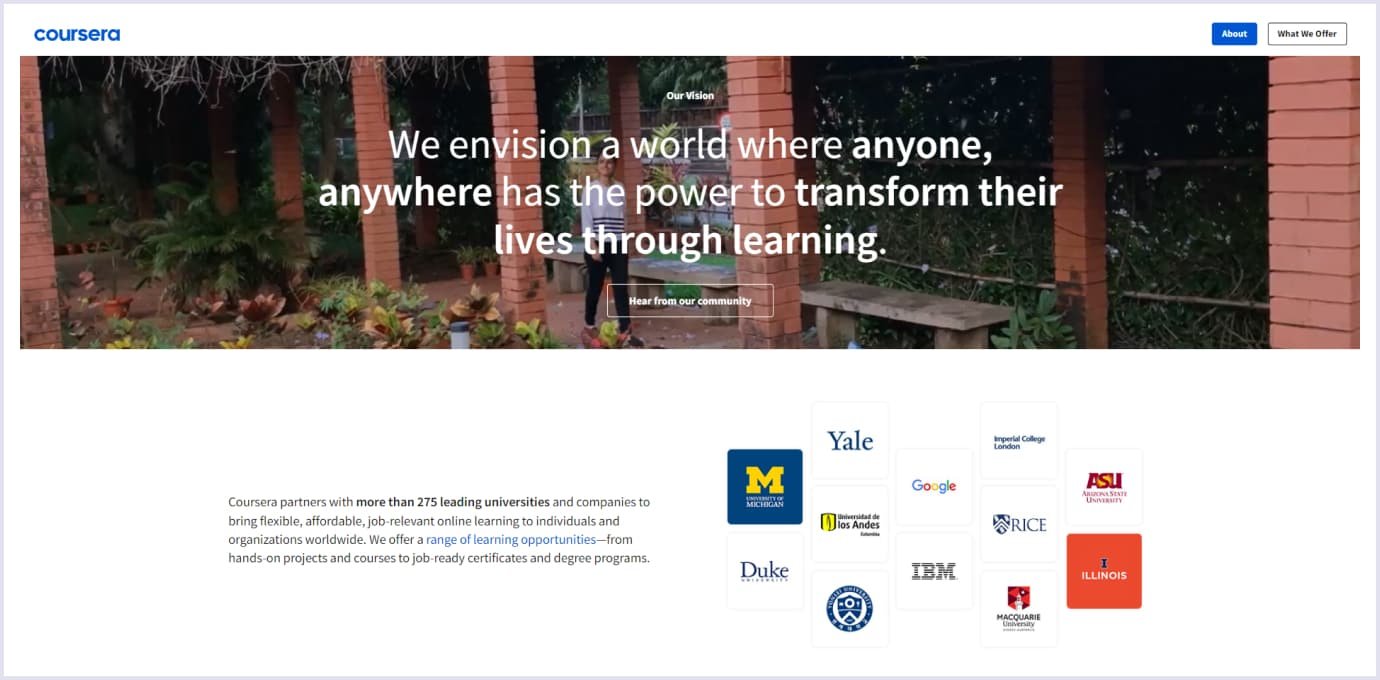
Source: Coursera
The principal value that the platform provides is university-level education, self-paced learning, and lower prices. The courses are accredited and acknowledged by companies.
Udemy and Coursera success factors
So, what distinguishes them from similar online learning platforms? Let’s find out.
- Advanced technology. It enables students to have a better learning experience.
- The competition-based pricing policy for courses with free educational options.
- Rating system. It allows for assessing both the expertise of the educators and the quality of the content.
- Educational content translated into different languages. Students get a chance to learn from the most qualified experts from all over the world.
- Course-creation toolkit for building free and premium courses.
- The extensive database of experts who are eager to share their experience.
The table below shows the main similarities and differences between Udemy and Coursera:
| Udemy vs. Coursera | ||
| Criteria | Udemy | Coursera |
| Foundation year | 2010 | 2012 |
| Number of courses | 250,000+ | 4,000+ |
| Number of users | 79M+ | 168M+ |
| Categories | Thousands of topics and subtopics | Strong focus on technology and business |
| Contributors | Anyone can create a course | Professionals from top universities and institutions |
| Bachelor’s and Master’s | No | Yes |
| Course price | Courses cost between $10 and $200+. Business plans for teams of 2 to 20 people are $360 per user annually. Enterprise plans for teams of more than 20 people and the leadership academy are to be discussed with the manager. | Courses are available for one-time, monthly, or annual fees. MasterTrack courses range between $2000 - $5000. Business plans vary depending on the number of users and the specific needs of the organization. |
| Certificates of completion | Generally not accredited except for a few | Accredited |
| Pros |
|
|
| Cons |
|
|
| Annual revenue | $786.6 million as of 2024 | $694.7 million as of 2024 |
| Market capitalization | $1.02 billion as of June 2025 | $1.33 billion as of June 2025 |
Monetization strategies for e-learning platforms
At first, e-learning providers did not charge their users. They supported the idea of free and open access to learning materials. However, when prestigious universities and companies started joining their platforms, the providers began monetizing their websites.
Below, we cover monetization strategies for e-learning platforms. Let’s look at examples of how online learning marketplaces like Udemy or Coursera generate income.
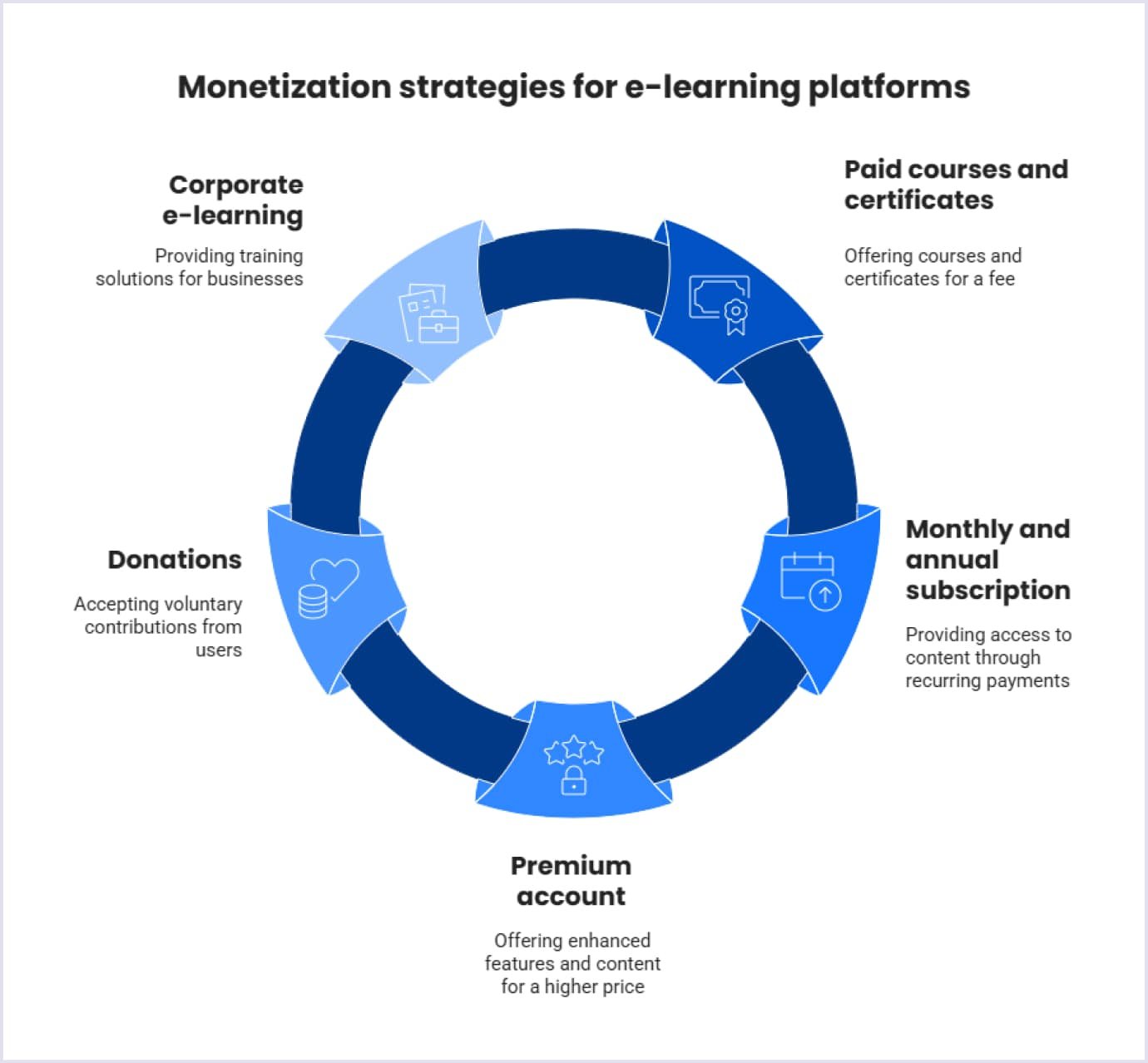
Paid courses and certificates
Generally, courses on the e-learning platforms are paid and include a certificate of completion. This is how Udemy works.
Some platforms combine paid and free options. For example, EdX allows learners to audit their courses for free. If students want to get a certificate of completion, it will range between $50 and $300.
Coursera also uses this approach. The platform suggests some courses as an audit without access to graded materials and as a purchasing option with a certificate. Also, Coursera offers a 7-day free trial for most courses and charges $49 monthly after the trial ends.
Monthly and annual subscription
Udacity offers some of the Nanodegree programs on a subscription basis. Learners can become experts in various areas, from Marketing Analytics to Data Visualization, for $249 per month or a discounted four-month subscription for $846.
Coursera offers two options with Coursera Plus. Users can access 7000+ courses, projects, and certificate programs for $59 per month or $399 annually.
Premium account
Skillshare provides users with minimal access to the service. At the same time, the account upgrade brings lots of extra possibilities. They get unlimited access to thousands of classes.
Donations
Khan Academy is a non-profit educational organization. All their resources are free. How can they make money? Well, they get donations from users and other non-profit institutions. For example, in 2010, Google donated Khan Academy $2 million to create new content and translate it into other languages.
In 2015, American multinational conglomerate AT&T donated $2.25 million to Khan Academy. The money was spent on building the mobile version. As a result, online courses became available for mobile users.
Corporate e-learning
It is a common practice for large companies to train their staff. E-learning websites like Udemy effectively serve this purpose. Both Udemy and Coursera offer the tools and materials required for employee learning.
To meet the needs for highly qualifying learning, the platform offers Udemy Business Content Opportunities. The Udemy content strategy team selects them and provides learning courses for teams and companies, ensuring high-quality content.
The main and unique functionality for the e-learning website
If you want to know how to build a website like Udemy, look closely at the core features of similar educational platforms. This functionality will help bring the learning experience to life.
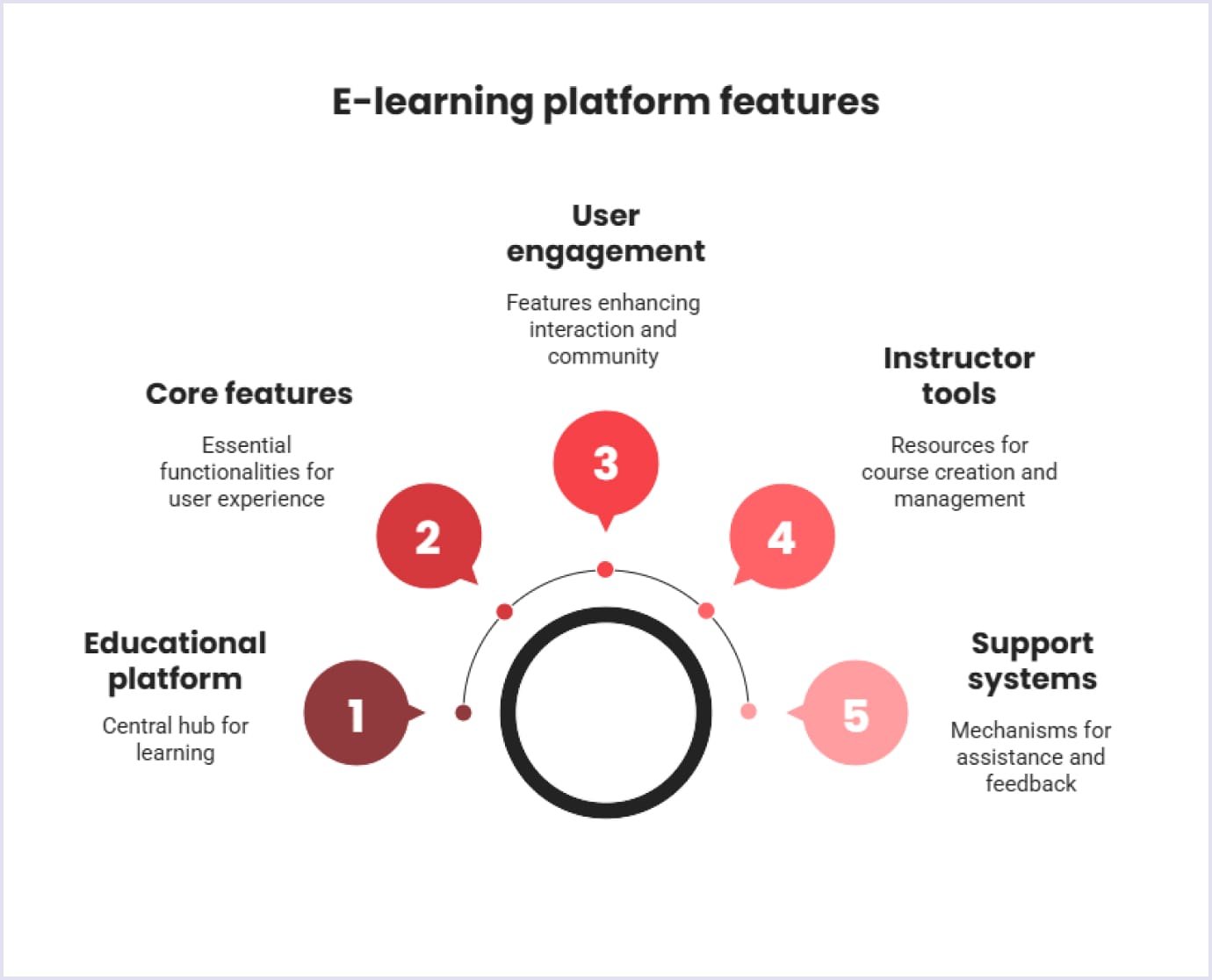
Search with autocomplete. Don’t make users look through an endless list of irrelevant options. Help them find the desired course with a predictive search function instead.
If you type a search word, Udemy suggests related terms. Also, search suggestions include relevant courses and instructors.
Filters. Allow students to choose classes based on different criteria. The most common of them are topic, subcategory, level, language, ratings, price, features, duration, and subtitles.
Recommendations. Create lists of trending courses and the most popular certificates. Highlight best-selling authors and thought leaders. These recommendations will help learners discover exciting things. At the same time, new users will have a good place to start.
Udemy offers a comprehensive set of courses for students. For example, before a student scrolls down to a list of courses, they can choose from suggestions. Udemy outlines courses for beginners with new and beginner favorites.
Coursera also offers personalized selections of courses. You can view degree courses, popular certificates, in-demand skills, and personalized courses, projects, and career paths.
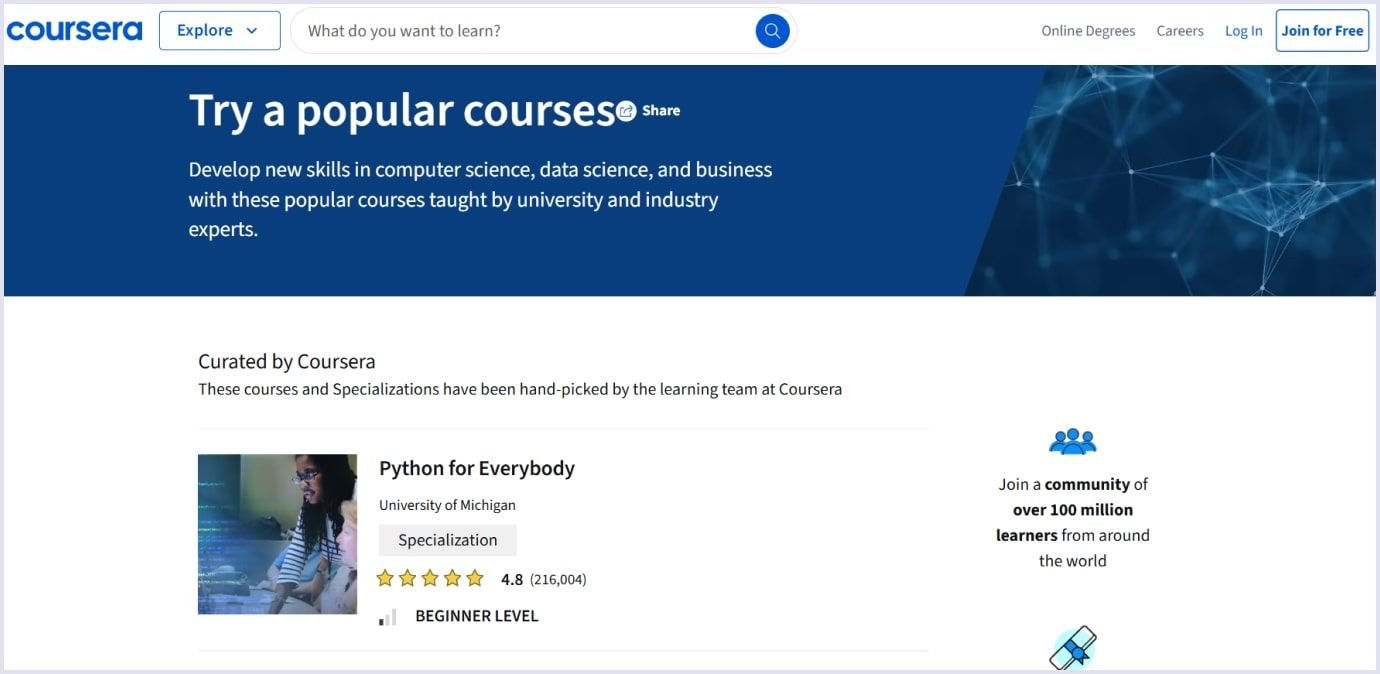
Source: Coursera
Feedback and rating system. This feature is necessary for promoting high-quality classes on a website like Udemy or Coursera. In addition, it makes it easier to weed out useless or irrelevant courses.
Categories. With an extensive system of categories, students can quickly find the desired classes. For example, Udemy offers courses in development, finance, marketing, design, photography, and more. Coursera’s categories cover data science, information technology, language learning, health, personal growth, and other subjects.
Easy sign-up. Students and instructors can sign up for an e-learning website with multi-factor authentication. Make it possible for users to sign up via Facebook or Google to save their time. Users should be able to set notification and message options, as well as close their accounts.
Student profile. Enable students to view the chosen courses and accomplishments. Wishlists and purchase history should be shown there as well. Udemy allows students to view all courses and add them to a wishlist or save them to My Lists. There are also archived courses that students can review and restore if needed.
Moreover, Udemy and Coursera student profiles include payment methods, subscriptions, and credits, so students can check them out quickly.
Course page. Provide students with general information about courses, their syllabus, reviews, and enrollment options. These data will help learners choose the right set of lessons.
On Udemy, every course suggestion comes with a brief description in a pop-up window. The popup also enables you to add the course to a cart or a wishlist.
Coursera gives information on the topic, instructors, level, experience, and time needed to complete a course.
Instructor profile. It should have a forum for communication with students and the instructor community. Besides, it will be a good idea to offer educators valuable resources, such as articles on teaching.
Course creation. Add the specific functionality for building online courses. Trainers should be able to define the structure of classes and upload learning materials in different formats. Also, make it easier for them to create engaging quizzes and assignments.
Dashboard. With its help, instructors on a website like Udemy can track their activity. Besides, the dashboard provides them with analytical data. It can include the number of students, ratings, traffic, and conversions.
For example, Udemy suggests helpful options for each of these aspects, providing deeper insights for teachers.
Communication. Udemy offers a set of communication features to give and receive feedback. The feature suggests a questions and answers section, messages, assignments, and announcements.
Multiple payment options. Provide students with convenient and secure payment gateways. It would be a great idea to allow purchasing courses via e-wallets (Apple Pay and Google Pay), a popular e-commerce marketplace development trend.
Admin panel. This important part of any e-learning website like Coursera is required for managing both content and users. You can add students to the blacklist, produce statistics reports, add new content to the blog, and assign user roles there.
Blog. It will keep learners updated about the latest courses and specializations. Besides, users can find useful tutorials and read the success stories of other students there.
Support. It is a challenging task to provide a great number of enrolled participants with excellent customer support. However, it is not an option to leave their questions and concerns unattended. Otherwise, students will feel frustrated and leave your platform. It will be a good idea to implement a system that sends automated emails with recommended steps for fixing a specific issue.
Udemy refund and credits systems. Udemy offers refunding to students so that they are more confident to purchase a course. Also, Udemy provides credits as a form of refund to help students explore more courses on the platform.
Udemy tools for creating better courses. The Udemy platform offers support for instructors. That is how they can receive advice on how to create a course video and how to add multiple coupons for courses. Also, Udemy provides instructors with helpful analytics on the topics students search for most.
Coursera MasterTrack certificates. Along with studying professional and university courses, a student can earn a certificate on Coursera. For example, the platform offers a MasterTrack certificate issued by a university. The MasterTrack module equals the university’s studying and counts toward the university’s Master’s course if a student pursues one. A student can include this certificate in their profile and share it in their resume or LinkedIn profile.
Coursera profile sharing with recruiters. Coursera enables students to share their profiles with potential employers. The Coursera profile includes experience and education. Students can upload completed projects, describe their work experience, and provide the education and skills they acquired.
AI in e-learning platforms. Today, artificial intelligence helps in many industries, and e-learning platforms are one of use cases. For example, Udemy uses an AI assistant that helps both learners and instructors. This chat-based tool helps resolve simple questions, summarizes key points in material, and assists instructors in handling routine queries. Moreover, AI simulates real-world scenarios to practice negotiations, job interviews, and giving feedback.
Check out the video below to see how Udemy leverages AI to make learning a better experience.
Coursera also uses AI. For example, Coursera Coach, an AI assistant, provides instant help by answering questions, encourages learners to test their understanding, and provides supportive feedback. Also, AI in Coursera helps learners with path mapping, recommends courses, assists with course creation, and more.
Both platforms continue to innovate with AI to help learners and instructors achieve their goals and maximize the benefits they derive from the platforms.
You may also like: How to Build an AI Agent for EdTech: A Step-by-Step Guide
Required technology stack
What technologies do Udemy and Coursera use? That is an exciting question for companies searching for the most suitable programming languages, frameworks, and tools for further elearning website development. Well, let’s peek under the hood.
Technical stack for building a website like Udemy
- Front-end
As for the client side, JavaScript, Angular, HTML5, and CSS3 are the core technologies for Udemy. They are helpful for creating desktop versions and education marketplace app development.
- Back-end
You may choose any proven technology for building the server side of your online education platform. For example, at Codica, we use Node.js to develop scalable, fast-loading, and secure online marketplaces.
What about building a website like Udemy? What platform is it built on? In their early days, Udemy chose PHP as the main programming language. It was used together with a custom MVC (model-view-controller) framework. However, with the rise of Python, the company decided to switch to this language, and the process has not yet been finished.
When it comes to databases, MySQL is the ultimate choice for Udemy. Also, Elasticsearch is widely used for search and analytics.
- Third-party tools and integrations
It is worth noting that the list of third-party tools used by Udemy is not limited to the technical aspect only. Trello, Dropbox, Slack, Salesforce, Zendesk - this is the incomplete list of instruments and applications that help the education marketplace achieve different business goals.
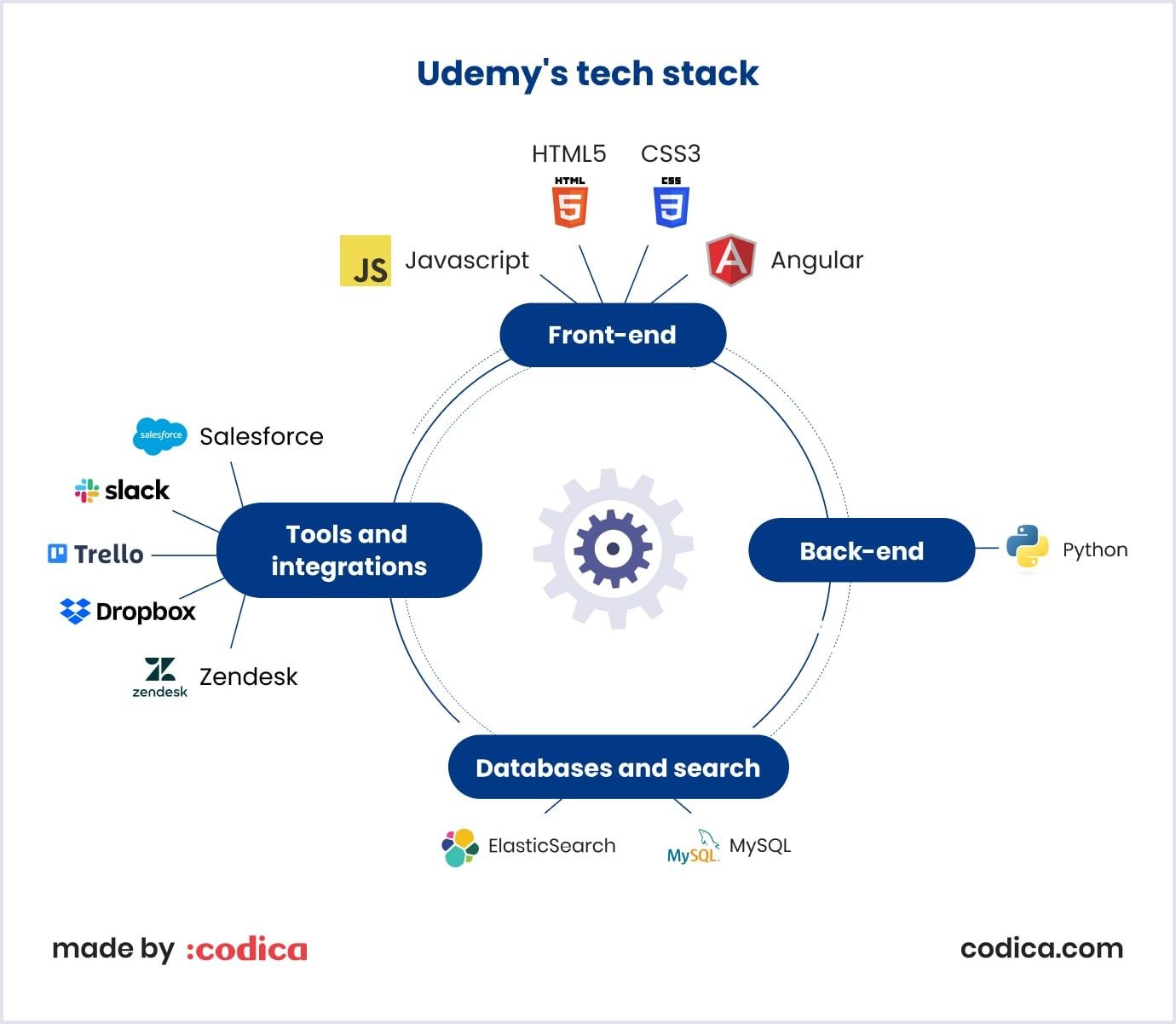
If you need software to help with team workflow, we are happy to create it. Our team provides custom enterprise software development services and builds business intelligence, content management, enterprise asset management, and other solutions.

Technical stack to build a website like Coursera
- Front-end
When it comes to client-side technologies, Coursera settled on JavaScript, React, and Bootstrap.
- Back-end
What platform does Coursera use? Well, the first lines of this e-learning platform were written in PHP. When the engineering team grew, the developers used Python and Go for some time. However, their final choice was Scala. It is still used by Coursera together with Play Framework.
Similar to Udemy, Coursera also chose MySQL to manage relational databases. In addition, the company uses Nginx as an HTTP server and Amazon S3 as cloud storage.
- Third-party tools and integrations
Finally, Coursera uses such popular collaboration and productivity applications as Jira, Slack, and G Suite.
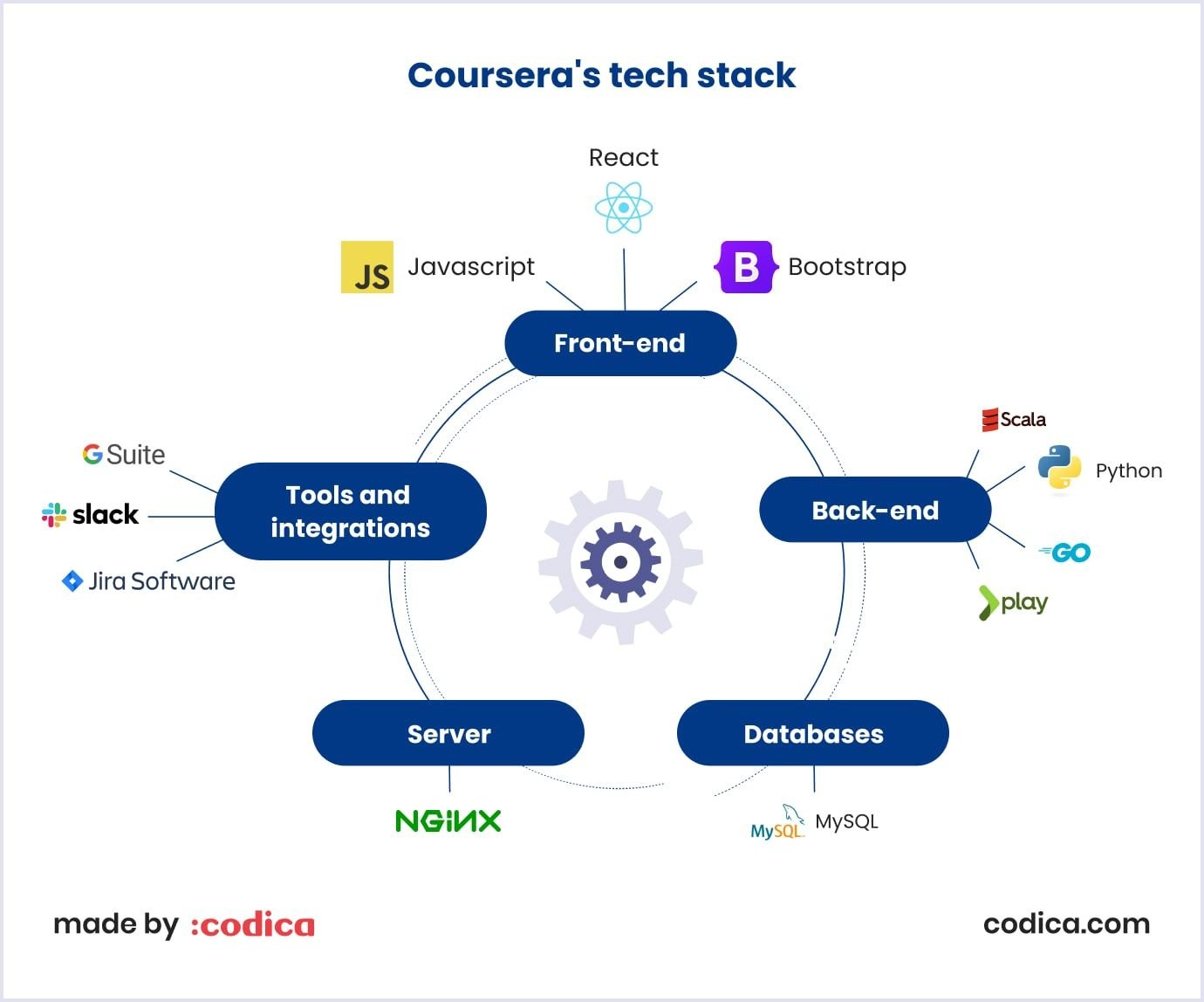
5-step guide on how to build an elearning website
Building an e-learning platform is a versatile task. We have comprehensive experience creating end-to-end solutions. So, let’s discover the crucial steps to develop an e-learning website.
1. Define your niche and goals with product discovery
So, you have decided to build elearning website. First of all, think about the courses that will be present there. Will they encompass a wide range of subjects, from arts and crafts to health and fitness? Or do you want to launch an industry-specific education marketplace?
If you decide to take the second path, it would be a sound idea to choose one of the most popular niches. They will attract many students and bring your platform much profit.
- Computers and technology
- Business and entrepreneurship
- Personal development
- Writing and content creation
- Arts and crafts
- Social sciences
After defining your niche, we recommend you proceed to product discovery. This is a preliminary step when our team verifies the product idea, its feasibility, and the resources for its implementation. During the project discovery phase, we conduct thorough market, design, and tech research to plan the product development.
As a result, you get product technical and financial estimates, clickable prototypes, and recommendations on architecture and team composition for building an elearning website. Check out the video below for a more detailed description of product discovery deliverables from our team.
2. UI/UX design
After prototypes have been agreed upon with the client, we proceed to design the product. Our UI/UX design services include prototyping at the research phase and visualization according to the client’s brand requirements.
Also, our designers create guidelines to help developers understand the product design. They help to optimize the design and development processes for sites like Coursera or Udemy.
For example, one of our projects is an online service marketplace that helps parents plan their children’s activities. When designing the platform, we considered the parents, their kids, and their needs.
That is why we selected children’s photos for design and added whimsical drawings. These UI elements resemble kids’ playful nature and bring joy and delight to the marketplace. Check out the video below to see how the service platform looks and works on mobile.
Further reading: How UX Design Solves Online Marketplace Issues
3. Development
When you are going to build a website like Udemy or Coursera to offer online courses, you have two options. You may build it from scratch or use one of the dozens of ready-made solutions that are available on the market.
Let’s take a look at the main benefits and downsides of each option.
Ready-made products
These solutions will allow you to build a website like Udemy for education in a matter of days. Such open-source software as Moodle or Joomla already has basic student management features and can be used as an e learning website builder. They also contain many free plugins that may come in handy, but the custom themes are not free. Besides, you may face issues with adding specific functionality.
Custom software development
Suppose you want to provide a great number of students with particular features. In this case, custom software development services are the best solution to build a website like Udemy or Coursera. Surely, it is more expensive and time-consuming, but it enables you to implement any required feature.
Custom e-learning website development is a versatile process that takes months of work and involves a team of skilled specialists. At Codica, we refined the custom development process regarding the best practices and latest standards. So, here is a breakdown of the steps needed to create websites like Udemy or Coursera.
Following the client’s requirements and design guidelines, our developers create the front-end and back-end sides of a product. We use the top technologies that have proven their efficiency over time to create reliable, stable, and delightful products.
For example, you want visitors to be logged out after 200 hours of their login time to avoid sharing login credentials. When you build your e-learning website from scratch, you can easily add such a feature.
We recommend our clients build e learning website as a minimum viable product (MVP). Being experts in MVP services, we ensure the development of a delightful MVP. So, you can get feedback from early adopters and spend the fewest resources on building your e-learning platform.
Also, you can create a mobile version of your e-learning website. We can provide you with high-standard cross-platform development services to ensure that you reach prospects who like studying on mobile devices.
4. Quality assurance
E learning website development goes hand in hand with quality assurance (QA). So, our team provides QA services to ensure the software works correctly and per product requirements.
We apply the latest technologies for performance, usability, integration, regression, and other types of manual and automated testing. Our QA team makes sure that test cases are clear and simple to help developers refine an e-learning solution.
5. Support and maintenance
When the product is ready, we provide support and maintenance with necessary improvements and updates. Our team will make the needed changes as you get user feedback on your product.
Further reading: Benefits of Custom Software Development for Small Business

The cost to create a website like Udemy or Coursera
The functionality we discussed above governs the total cost of e-learning website development.
To make things easier for you, we created a table with the approximate costs of must-have features when you develop e learning platform. You can see it below:
| The cost of creating an e-learning website like Udemy or Coursera | ||
| Features | Time, hours | Cost ($50/h) |
| Design | ||
| UX development | 64 | $3,200 |
| UI development | 96 | $4,800 |
| Architecture | ||
| Project setup | 16 | $800 |
| DB structure | 32 | $1,600 |
| Integrations | ||
| Payment (Stripe or PayPal) | 64 | $3,200 |
| Main functionality | ||
| Authorization and security | 72 | $3,600 |
| User profiles | 42 | $2,100 |
| Home page | 48 | $2,400 |
| Search and filters | 64 | $3,200 |
| Product page | 80 | $4,000 |
| Reviews and ratings | 32 | $1,600 |
| Shopping cart | 64 | $3,200 |
| Notifications | 32 | $1,600 |
| Course page (Course overview, course content, Q&A, Announcements, Bookmarks) | 80 | $4,000 |
| Course creation (the ability to upload content in different formats, create quizzes and tests) | 96 | $4,800 |
| Dashboard for teachers (analytical information about students) | 96 | $4,800 |
| Course management | 54 | $2,700 |
| Admin panel | 96 | $4,800 |
| Non-development activity | ||
| Project management | 64 | $3,200 |
| Quality assurance | 80 | $4,000 |
| Code review | 32 | $1,600 |
| Total | 1304 | $65,200 |
Therefore, the preliminary cost of creating an online education website like Udemy is $65,200. Note that the numbers in the table are rough estimates for a minimum viable product (MVP). So, your development partner will provide you with the final amount for your particular project of an online learning platform.
How to promote an e-learning platform
So, you have launched your e-learning platform. What’s next? Indeed, you need a solid marketing strategy to help you make your platform’s virtues visible to a broad audience. Promoting your platform is a constant process, with necessary adjustments over time regarding user feedback and current trends.
Below, we have prepared a list of techniques to help you stay ahead of the competition and win more customers. Let’s check them out.
- Build an engaging website. Your site is the first point of contact for your customers. Ensure that it is delightful, works properly, and is optimized for search engines. Choose personalization and accessibility tools to ensure different users are comfortable navigating it.
For example, our team redesigned a boat sale website, and it brought lead generation up 480% compared to the previous platform. This is a case showing how important it is to have an intuitive and appealing site for better business results.
- Offer free courses. This approach supports the primary value of online education, which is its availability for many people. Also, it will help you attract customers who can switch from free to paid courses over time.
- Connect with influencers. When partnering with influencers, ensure they have followers curious about e-learning. So, you will reach a broad audience and people who are genuinely interested in your platform’s services.
- Networking and attending events. Participating in forums, webinars, online communities, and events will help you connect with potential instructors. Also, spreading the word about your platform will attract more learners and investors, which will contribute to the development of your platform.
- Share your platform improvements. For example, Udemy shares what enhancements they have made. Showing that you stay at the forefront of e-learning trends and technologies will help you keep your customers engaged and give them more opportunities.
Summing up
Coursera and Udemy have become the world’s leading e-learning providers. So, building a website like Udemy or Coursera can be a good business idea. Now that you know how to create e-learning website, it will be easier for you to pave your way to success.
However, it will not be enough to make their clone achieve the same success. Create a unique product with exceptional functionality. In this case, you can succeed in this highly competitive environment.
Are you seeking a development team to build an online learning platform? Codica specializes in online marketplace development for various industries, including e-learning platforms. We know how to build a website like Udemy or Coursera and will be happy to help you become a leader in the electronic education domain. Check out our portfolio or contact us to discuss your project.

